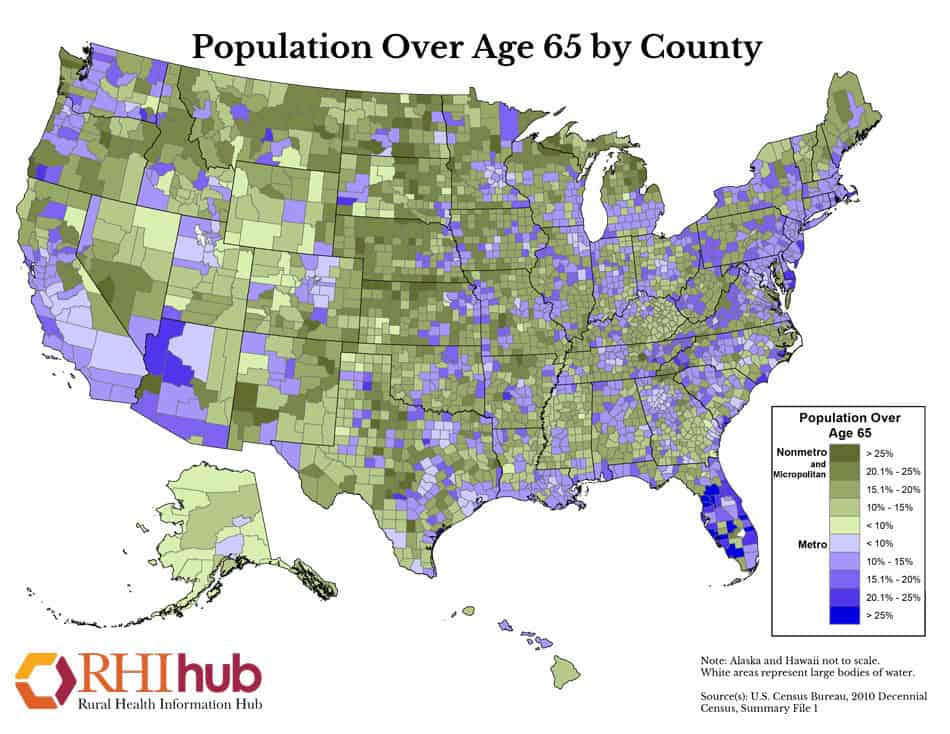Demographic Aging Trends in America: Expanding health policies beyond our cities
January 16th, 2020 | viewpoint
If you are in a major U.S. city and happen to be staring out the window, chances are slim that the people you see are an accurate reflection of the U.S. population.
Cities are more racially and ethnically diverse than most suburban or urban areas, and they’re considerably younger. The U.S. population is aging, but you wouldn’t know it by scanning the streets of most major cities. Evidence of the changing demographic is not visible everywhere.
A dramatic age shift began in the United States near the end of the so-called “baby boom” period, around 1960, ushered in by declining birth rates and advances in public and private health care that resulted in greater longevity. By 2034, the U.S. Census Bureau projects that people 65 and older will outnumber children under age 18 for the first time in U.S. history.
But what you see may depend on your vantage point because where we live as we age is also changing. A 2018 Pew Report on American life demonstrates that the older adult population (age 65 and older) has grown by 39% in suburban communities since 2000, by 26% in rural communities, and by only 22% in urban settings.

This map illustrates these trends. You’ll notice a greater proportion of older adults in rural settings, in part because young adults often migrate to cities for work, while older adults remain in their original communities. In most expanding U.S. cities, growth is primarily due to the migration of younger adults.
During the recession of 2007–2009, the U.S. population migration stalled. Data from the 2018 U.S. Census Community Survey, however, illustrate a gradual return of population migration—but with shifts in metropolitan area preferences and divisions by age. Perhaps unsurprisingly, regions that attracted older adults did not overlap with those selected by millennials. Between 2012 and 2017, millennials 25 to 34 gravitated in large numbers to Houston, Denver, Dallas, Seattle, and Austin, while baby boomers (age 55 and older) gravitated to Phoenix, Tampa, Riverside, Las Vegas, and Jacksonville. If you’re in downtown Denver, the population on the street is predominantly young. If you’re in Jacksonville, FL, it will look much older. Of course, many people over age 65 are no longer in the workforce, and that is why they are not as visible in professional urban centers, but retirement alone doesn’t explain everything.
U.S. demographic shifts also reveal significant changes in racial and ethnic diversity, especially in urban and suburban populations. While our nation is becoming more diverse, this diversity, especially among older adults, tends to be concentrated in urban, suburban, and southern rural areas. Regardless of location, racial and ethnic minorities experience health disparities, and those disparities are amplified as they age.
All this is to say that the age demographics of the United States are changing, and these changes will have a profound effect on economics, policy, community design, education, and health. But these important issues may not grab our attention because the aging of America is slow, so slow it may not be noticed by policymakers, community officials, or voters. According to the Census Bureau, only 3% of the U.S. landmass is urban, while nearly 80% of people reside there. Rural accounts for 97% of the U.S. landmass, but only 20% of the population resides there.
These trends will not reverse over time; they will continue, although U.S. life expectancy has declined in the last 3 years due to premature deaths among adults 25 to 64. In 1960, when most of our national infrastructure was conceived and under construction, only 10% of the population was 65 and older. By 2060, when nearly all the baby boomers will have passed on, one-quarter of the population will be age 65 and older. Millennials and Gens X, Y, and Z-ers are all headed in the same direction and will reach our current definition of older adulthood by 2060. Our challenge is to recognize that change from wherever we sit and build a social infrastructure that accommodates the expansion of longevity and invites all to participate as fully as possible.
Written by Margaret Franckhauser
We strive to build lasting relationships to produce better health outcomes for all.